Must-Try Korean Food Dishes – Delicious Korean Cuisine
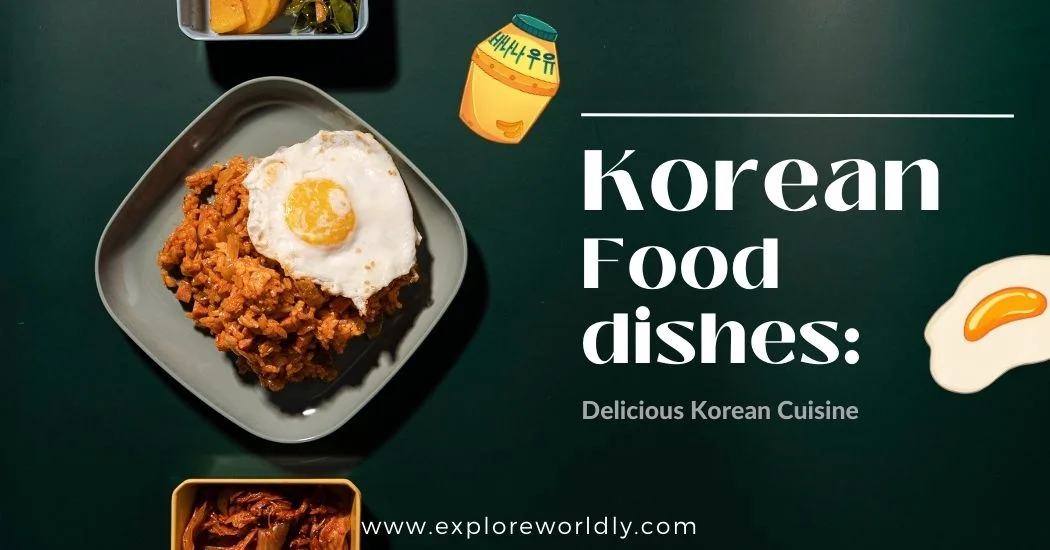
Korean food offers a rich tapestry of flavors and customs that has enchanted culinary enthusiasts across the globe. Known for its bold and diverse tastes, Korean food offers a delightful mix of spicy, sweet, savory, and umami flavors. This extensive exploration will examine the must-try Korean food dishes that ignite your taste buds and leave you craving more.
Exploring the wonders of Korean cuisine, one bite at a time.
A standard Korean meal includes a serving of rice, a bowl of soup or stew, and an assortment of side dishes. However, within this fundamental framework exists a wonderfully diverse range of dishes to suit every season and taste.
Kimchi – The Quintessential Korean Food
Kimchi, the undisputed star of Korean cuisine, is a flavorful and fiery fermented vegetable dish. The primary ingredients in this dish are Napa cabbage, radishes, and a complex blend of spices. What makes kimchi unique is the combination of sourness, spiciness, and umami that creates a symphony of flavors in your mouth. This iconic side dish is delicious and rich in probiotics, making it a perfect accompaniment to any Korean meal.
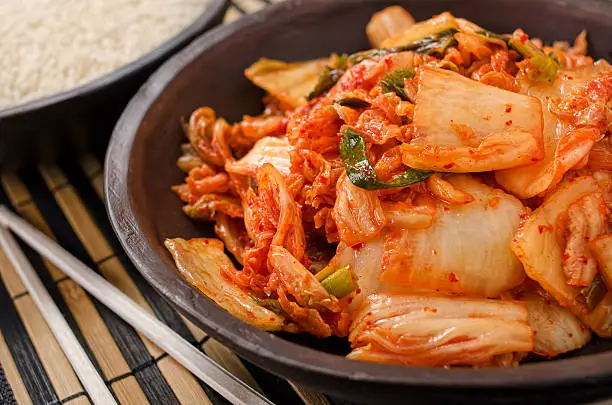
The Art of Kimchi-Making: Making kimchi is a cultural tradition in Korea, especially during the fall when households prepare large batches to last through the winter. The process involves salting and fermenting the vegetables, allowing the development of complex flavors over time.
Kimchi love forever!
ReBulgogi – Sweet and Savory Grilled Beef
Bulgogi is a mouthwatering Korean dish that showcases the art of marinating and grilling beef. Thinly cut beef is soaked in a delightful and savory marinade, usually comprising soy sauce, sugar, garlic, and sesame oil. The marinated beef is then grilled to perfection, resulting in tender, flavorful slices often wrapped in lettuce leaves and served with various condiments. Bulgogi is the epitome of balance in Korean cuisine, where sweet and savory flavors create a harmonious and satisfying experience.

Bulgogi Variations:
- Beef is the most common choice for Bulgogi.
- Variations include chicken (Dak Bulgogi) and pork (Daeji Bulgogi).
- Each version adds its unique character to this beloved Korean dish.
Bibimbap – A Colorful Bowl of Goodness
Feasting on some Bibimbap – a true explosion of flavors!
Bibimbap translates to “mixed rice,” and it is indeed a colorful bowl of goodness. This vibrant and nutritious dish features a base of rice topped with various vegetables, a protein source (usually beef or tofu), and a spicy sauce, typically Gochujang, a red chili paste. The burst of flavors and textures matches the visual appeal of this dish as you mix it all together. Bibimbap is a favorite for both its taste and its visual aesthetics.
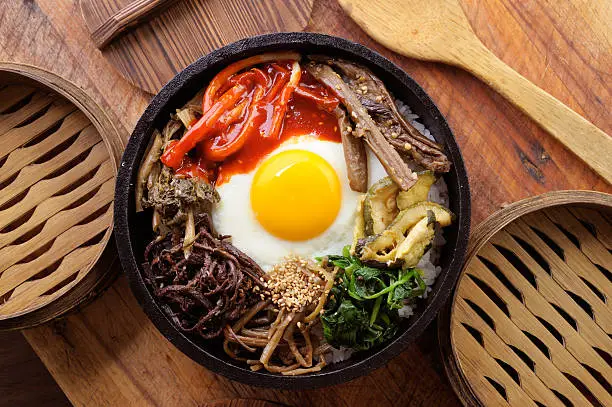
Bibimbap Variations:
- Bibimbap has numerous regional variations in Korea.
- One famous version is Dolsot Bibimbap.
- Dolsot Bibimbap is traditionally served in a sizzling hot stone pot.
- It creates a crispy layer of rice at the bottom.
Jjajangmyeon – Korean-Chinese Fusion
Jjajangmyeon is a fascinating Korean-Chinese fusion dish that has carved a special place in Korean cuisine. It features a hearty bowl of noodles topped with a rich black bean sauce and various vegetables. The sauce, made from black soybean paste, is savory and slightly sweet, creating a unique flavor profile. Jjajangmyeon is a comfort food that resonates with both kids and adults.

Cultural Fusion:
The influence of Chinese cuisine on Korean food can be traced back to the late 19th century when Chinese immigrants introduced dishes like Jjajangmyeon to Korea.
Tteokbokki – Spicy Rice Cake Stew
Tteokbokki is a beloved Korean street food with a spicy kick and a chewy texture. This dish features cylindrical rice cakes cooked in a fiery red chili sauce, often garnished with fish cakes and boiled eggs. Tteokbokki’s uniqueness lies in combining heat and a delightful chewiness that creates an addictive and memorable experience.
Treating myself to some Tteokbokki – the perfect blend of sweet and spicy.
Korean Street Food:
Tteokbokki is a staple in Korean street food stalls, where vendors prepare it fresh, offering both locals and tourists a spicy and satisfying snack.
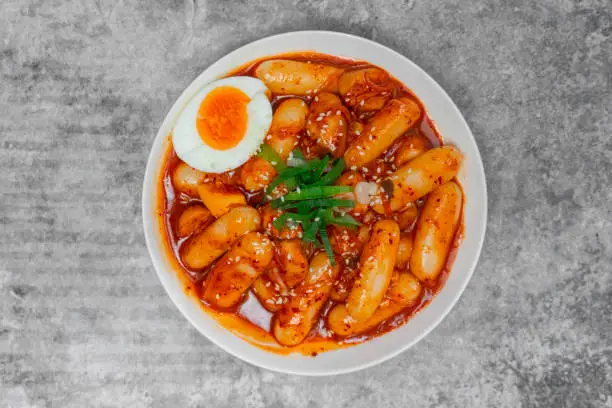
Samgyeopsal – Grilled Pork Belly
Samgyeopsal is a highlight in Korean barbecue restaurants, and it’s a dish that celebrates the joy of grilling meat at your table. This Korean BBQ delight features thick slices of pork belly that are perfectly grilled. As you enjoy the sizzling sounds and enticing aromas, you can wrap the grilled meat in lettuce leaves and add various condiments for a personalized flavor explosion.
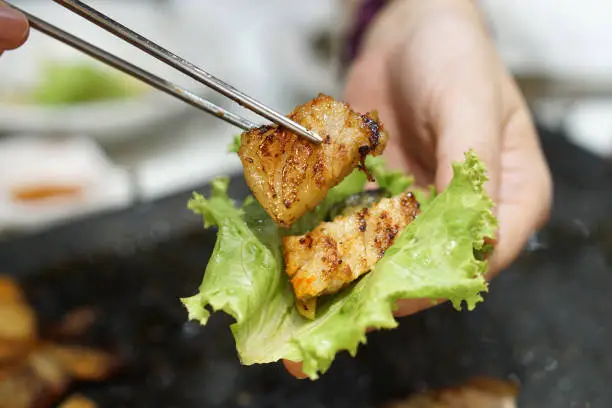
DIY Korean BBQ:
Samgyeopsal epitomizes the interactive and communal aspect of Korean dining. Grilling and sharing your meat with others is a cherished social tradition.
Kimbap – Korean Sushi Rolls
Kimbap, often called the Korean version of sushi, is a versatile and portable dish. It consists of rice and various ingredients, such as vegetables, meat, and pickled radish, rolled in seaweed sheets. Kimbap is a popular quick meal, picnic, or snack choice. Its compact size and colorful ingredients make it a favorite among Koreans of all ages.
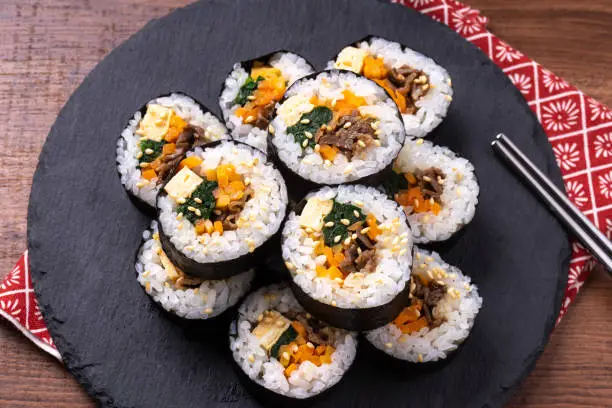
Seaweed Innovation:
The use of seaweed in Kimbap is a testament to the resourcefulness of Korean cuisine, utilizing the sea’s bounties to create delicious and satisfying dishes.
Japchae – Stir-Fried Sweet Potato Noodles
Japchae is a Korean dish that showcases the versatility of sweet potato noodles. The dish features these translucent noodles stir-fried with vegetables, meat, and a soy sauce-based seasoning. The combination of textures, flavors, and a touch of sweetness creates a satisfying and comforting dish that is perfect for any occasion.
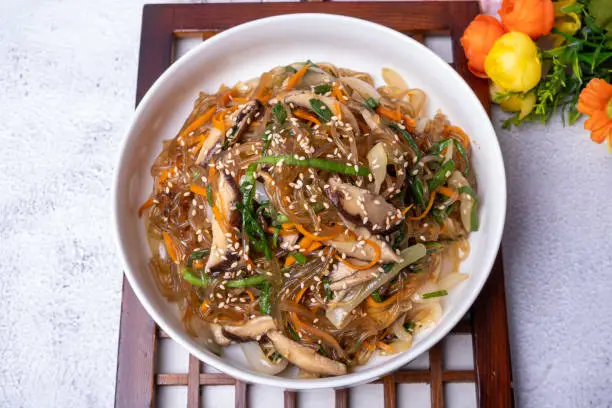
Cultural Significance:
Japchae is often featured in celebrations and special occasions in Korea, symbolizing longevity and the hope for a long and happy life.
Sundubu Jjigae – Silken Tofu Stew
Sundubu Jjigae is a soothing and spicy Korean stew with silken tofu as its star ingredient. The hash is enriched with seafood, vegetables, and a flavorful broth. The balance between the heat and the gentle flavors of tofu make Sundubu Jjigae a comforting and soothing choice, especially on a chilly day.

Spicy Healing:
Sundubu Jjigae is believed to have medicinal properties, and many Koreans enjoy it as a remedy for hangovers or to invigorate the body.
Haemul Pajeon – Seafood Pancake
Haemul Pajeon is a savory Korean pancake that celebrates the abundance of seafood. This pancake is made by mixing a variety of seafood, such as shrimp, squid, and green onions, in a batter. The result is a crispy exterior and a soft, flavorful interior. It’s often enjoyed with a dipping sauce, creating a delightful harmony of textures and tastes.
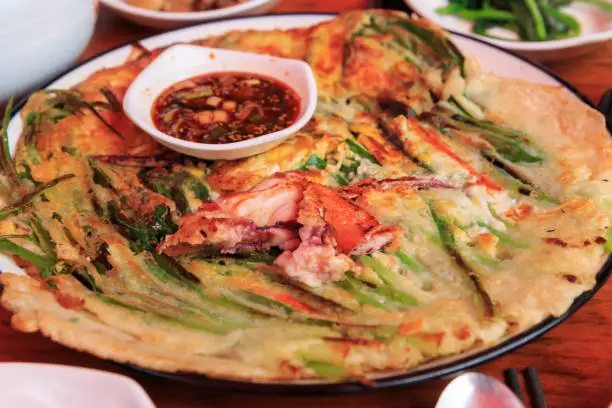
Seasonal Delight:
Haemul Pajeon is a popular dish during the monsoon season in Korea, as it pairs perfectly with the sound of rain falling outside.
Korean cuisine is not just about food; it’s about the experience. These must-try Korean food dishes are a testament to the creativity, complexity, and soulful nature of Korean cooking. Each dish embodies a unique combination of flavors and cultural significance, inviting you to explore the richness of this culinary tradition.
Best 4 Korean Food to Try in Winter
Winter in Korea is a magical time, and the cuisine during this season offers a warm and comforting experience. Here are the best four Korean foods to try during the winter months:
Tteokguk – Rice Cake SoupTteokguk
Tteokguk – Rice Cake SoupTteokguk, or rice cake soup, is a traditional Korean dish with great cultural significance, especially during the Lunar New Year, which typically falls in winter. The chef prepares this hearty soup using cylindrical rice cakes, a clear broth and garnishes such as sliced seaweed, eggs, and scallions.
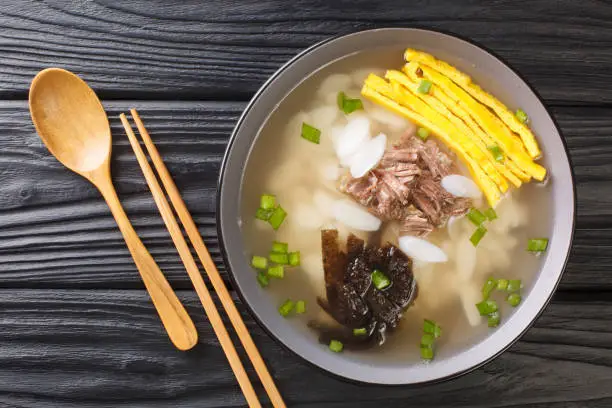
- The round shape of rice cakes symbolizes good luck and longevity.
- It is considered a must-have during the festive season for this reason.
Jeon – Assorted Pancakes
Jeon is a delightful array of savory Korean pancakes that are especially popular during winter. They come in various forms, with the most common types being Kimchi Jeon (made with kimchi), Pajeon (green onion pancakes), and Hobak Jeon (zucchini pancakes). These pancakes are crispy on the outside and soft on the inside, offering a satisfying contrast in textures. They’re perfect for sharing with family and friends, making them a popular choice for gatherings during the winter season.
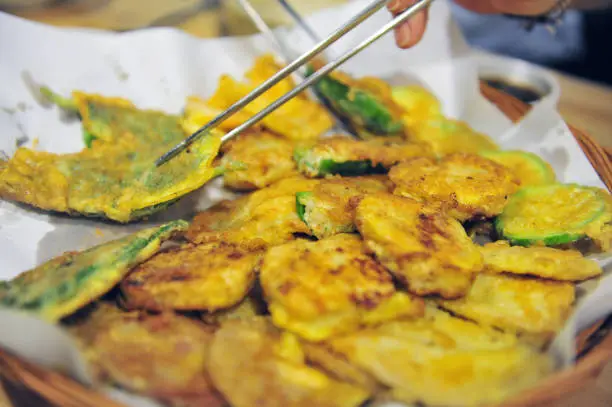
Hotteok – Sweet Pancakes
Hotteok is a sweet pancake that’s a beloved street food during the winter months. The dough is made from wheat flour and filled with lovely brown sugar, cinnamon, and crushed nuts. When cooked, the filling melts, creating a warm and gooey center. The scent of hotteok sizzling on griddles fills the streets, making it an irresistible treat to warm up your chilly winter day.
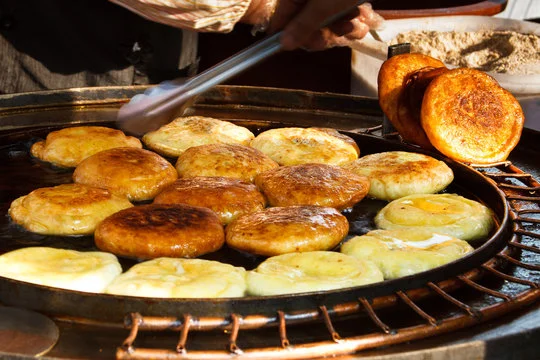
With their unique flavors and cultural significance, these four Korean foods are the perfect choices to try during the winter season in Korea. Whether marking a special occasion or seeking a comforting meal, these dishes will unquestionably warm your heart and please your palate.
Conclusion
In conclusion, Korean cuisine is a culinary journey that takes you through various flavors, textures, and traditions. Each dish tells a story of Korean culture and heritage, from the fiery kimchi spice to the soothing comfort of Sundubu Jjigae. Whether you’re exploring the vibrant streets of Seoul or trying these dishes at home, you’re in for a gastronomic adventure that will leave you with a lasting appreciation for Korean cuisine.
FAQs-Must Try Korean Food Dishes
What is the key flavor profile of Korean food?
Korean food is famous for its robust flavors, often featuring a combination of spicy, sweet, savory, and umami tastes.
Is Korean food suitable for vegetarians and vegans?
Many Korean dishes can be adapted to vegetarian or vegan diets by substituting meat or animal-based ingredients with plant-based alternatives.
Where can I find authentic Korean ingredients for cooking at home?
You can typically find Korean ingredients in Asian grocery stores or online markets specializing in international foods.
What are some popular Korean desserts to try after a meal?
Popular Korean desserts include bingsu (shaved ice), hotteok (sweet pancakes), and rice cakes.
Are there regional variations in Korean cuisine?
Korean cuisine can vary by region, with different areas having specialties and local ingredients.
Tag a friend who needs a Korean food intervention.
Ultimately, Korean cuisine is a treasure chest waiting to be explored, offering a sensory experience that combines tradition, innovation, and a deep love for food. So, embark on your culinary journey and savor the delights of Korean cuisine. Your taste buds will thank you.
